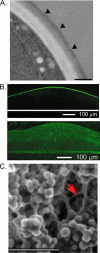Cell signals, cell contacts, and the organization of yeast communities
- PMID: 21296916
- PMCID: PMC3127636
- DOI: 10.1128/EC.00313-10
Cell signals, cell contacts, and the organization of yeast communities
Abstract
Even relatively simple species have evolved mechanisms to organize individual organisms into communities, such that the fitness of the group is greater than the fitness of isolated individuals. Within the fungal kingdom, the ability of many yeast species to organize into communities is crucial for their growth and survival, and this property has important impacts both on the economy and on human health. Over the last few years, studies of Saccharomyces cerevisiae have revealed several fundamental properties of yeast communities. First, strain-to-strain variation in the structures of these groups is attributable in part to variability in the expression and functions of adhesin proteins. Second, the extracellular matrix surrounding these communities can protect them from environmental stress and may also be important in cell signaling. Finally, diffusible signals between cells contribute to community organization so that different regions of a community express different genes and adopt different cell fates. These findings provide an arena in which to view fundamental mechanisms by which contacts and signals between individual organisms allow them to assemble into functional communities.
Figures




Similar articles
-
Cyc8p and Tup1p transcription regulators antagonistically regulate Flo11p expression and complexity of yeast colony biofilms.PLoS Genet. 2018 Jul 2;14(7):e1007495. doi: 10.1371/journal.pgen.1007495. eCollection 2018 Jul. PLoS Genet. 2018. PMID: 29965985 Free PMC article.
-
Modifying Saccharomyces cerevisiae Adhesion Properties Regulates Yeast Ecosystem Dynamics.mSphere. 2018 Oct 24;3(5):e00383-18. doi: 10.1128/mSphere.00383-18. mSphere. 2018. PMID: 30355663 Free PMC article.
-
Physiological regulation of yeast cell death in multicellular colonies is triggered by ammonia.J Cell Biol. 2005 Jun 6;169(5):711-7. doi: 10.1083/jcb.200410064. J Cell Biol. 2005. PMID: 15939758 Free PMC article.
-
Choosing the right lifestyle: adhesion and development in Saccharomyces cerevisiae.FEMS Microbiol Rev. 2012 Jan;36(1):25-58. doi: 10.1111/j.1574-6976.2011.00275.x. Epub 2011 May 20. FEMS Microbiol Rev. 2012. PMID: 21521246 Review.
-
Reactive oxygen species and yeast apoptosis.Biochim Biophys Acta. 2008 Jul;1783(7):1354-68. doi: 10.1016/j.bbamcr.2008.01.023. Epub 2008 Feb 11. Biochim Biophys Acta. 2008. PMID: 18298957 Review.
Cited by
-
Sociobiology of the budding yeast.J Biosci. 2014 Apr;39(2):225-36. doi: 10.1007/s12038-013-9344-5. J Biosci. 2014. PMID: 24736156 Review.
-
Dimorphism of Trichosporon cutaneum and impact on its lipid production.Biotechnol Biofuels. 2019 Aug 29;12:203. doi: 10.1186/s13068-019-1543-3. eCollection 2019. Biotechnol Biofuels. 2019. PMID: 31485269 Free PMC article.
-
Transcription factor regulation and chromosome dynamics during pseudohyphal growth.Mol Biol Cell. 2014 Sep 1;25(17):2669-76. doi: 10.1091/mbc.E14-04-0871. Epub 2014 Jul 9. Mol Biol Cell. 2014. PMID: 25009286 Free PMC article.
-
Diverse conditions support near-zero growth in yeast: Implications for the study of cell lifespan.Microb Cell. 2019 Aug 20;6(9):397-413. doi: 10.15698/mic2019.09.690. Microb Cell. 2019. PMID: 31528631 Free PMC article. Review.
-
Cyc8p and Tup1p transcription regulators antagonistically regulate Flo11p expression and complexity of yeast colony biofilms.PLoS Genet. 2018 Jul 2;14(7):e1007495. doi: 10.1371/journal.pgen.1007495. eCollection 2018 Jul. PLoS Genet. 2018. PMID: 29965985 Free PMC article.
References
-
- Beauvais A., Loussert C., Prevost M. C., Verstrepen K., Latge J. P. 2009. Characterization of a biofilm-like extracellular matrix in FLO1-expressing Saccharomyces cerevisiae cells. FEMS Yeast Res. 9:411–419 - PubMed
-
- Bedard K., Krause K. H. 2007. The NOX family of ROS-generating NADPH oxidases: physiology and pathophysiology. Physiol. Rev. 87:245–313 - PubMed
-
- Blankenship J. R., Mitchell A. P. 2006. How to build a biofilm: a fungal perspective. Curr. Opin. Microbiol. 9:588–594 - PubMed
Publication types
MeSH terms
Substances
Grants and funding
LinkOut - more resources
Full Text Sources
Molecular Biology Databases

